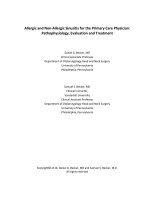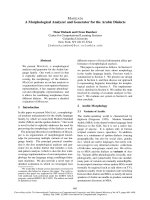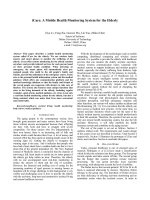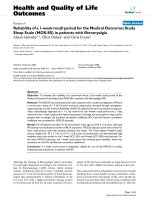Ceramics,-A-Synthetic-Non-Silica-Alternative-for-the-Metal-Casting-Process,-Claude-Krause-2018
Bạn đang xem bản rút gọn của tài liệu. Xem và tải ngay bản đầy đủ của tài liệu tại đây (3.68 MB, 34 trang )
Ceramics, A Synthetic Non-Silica
Alternative for the Metal Casting
Process
Claude A. Krause
Director, Business Development &
Sr. Technical Advisor
carboindustrial.com
Engineered Ceramics – Overview
– Ceramic media has been used for a number of years in the global metal
casting market.
– A 1995 DOE/University of Western Michigan study identified two ceramic
products tested were viable alternatives to replace silica sand for the US Metal
Casting Industry.
– The major use has been as a substitute for silica and specialty sands for core
and facing applications where quality requirements warranted the higher
performance.
– Aside from Lost Foam, fully charged ceramic systems have been limited in the
US, mostly due to:
– Highly abundant and low cost silica sand
– An industry reluctant to change
– Higher cost of ceramics.
Engineered Ceramics – Product Technology
Engineered synthetic ceramic products provide
consistent chemical, thermal and physical
properties through tightly controlled:
– Composition
– Sizing
– Shape
Resulting in consistent, repeatable casting
performance.
CARBO Engineered Ceramic Casting Media
AVAILABLE IN A RANGE OF SIZES AND DENSITIES:
High-performance,
low-density
ceramic casting
media
High-performance,
intermediatedensity ceramic casting
media
Ultra-high
performance, lowdensity ceramic
casting media
Controlled Composition – Creates Mullite and
Corundum Crystals
Mullite provides low, linear
expansion & high thermal
stability.
Corundum provides high
hardness & durability & high
thermal stability
Controlled Composition – Provides Low Linear
Expansion
Controlled Composition – Provides High Thermal
Stability
Low Linear Expansion and High Thermal Stability
IMPROVES
DIMENSIONAL
ACCURACY
REDUCES ADDITIVES,
DEFECTS,
SCRAP & CLEANING
High Hardness and Durability
REDUCES MEDIA
CONSUMPTION
DECREASES
TRANSPORTATION,
DISPOSAL AND
REPLACEMENT
MEDIA COSTS
IMPROVES
RECLAMATION,
REUSE
Controlled Sizing – Eliminates the Distributions
Fine Tail, Provides Higher Permeability
Size Distribution (mesh)
Permeability
Uniform Size and Shape
MAXIMIZES
MOLD
POROSITY
ENHANCES
PERMEABILITY
REDUCES
GAS DEFECTS
CARBO Engineered
ceramic casting
media
Naturally occurring
silica sand
Excellent Roundness
IMPROVES
FLOWABILITY
INCREASES
PRODUCTION
CYCLE RATES
Low Linear Expansion Impact
(2)
1. Marine aluminum
engine block –
improved dimensional
precision, salvaging
multi-billion$ project
2. Low alloy carbon steel –
minimized hot tear and
crack defects
3. Steel gear sprocket –
reduced cleaning time
20–30 to 10 hours
(1)
(3)
High Thermal Stability Impact
Shell Process, Grey & Ductile
Increases in casting
complexity magnifies ceramic
thermal impact.
(1)
(1)
1. Part 1
•
•
•
•
More stable dimensions
Cleaner internal passageways
Reduced burn in
Eliminated heat stress crack
defect
(2)
2. Part 2
•
•
Eliminated burn in and fins
Provided a 75% reduction in
internal cleaning time
3. Part 3
•
•
Clean internal passageway and
tight
dimensional stability.
Avoided capital outlay for new
cleaning equipment
(3)
High Flow Property Impact
Automotive aluminum
engine block
Increased production rate
27%.
Eliminated 9% scrap.
Effectively realized 36%
production increase
avoiding new equipment
purchase.
Automotive Engine Block
Industry
Challenge
Identify and focus on
the true “Elephant in
the Room”!!!
“PEL”
Permissible exposure limits to
Quartz silica
New OSHA PEL Regulation
OSHA has lowered the
“permissible exposure
limit” (PEL) to
crystalline quartz silica
from 100 to 50 μg/m3.
This is equivalent to a
teaspoon of silica dust
in the volume of a
football field 30 meters
high (157,800 m3).
Conversion – Approach Options
Extended blending conversion
–
–
–
–
Produce cores w/100% ceramic casting media.
Allow ceramic core material to filter into the silica molding system.
Track ceramic/silica system ratio through conversion completion.
Estimated time to achieve full conversion ≈ 4 years.
Instantaneous conversion
– Clean out entire foundry operation removing all silica sand and dust from
facility.
– Introduce 100% ceramic casting media to both the core and mold
systems.
Engineered Ceramics – Conversion 1
Steel, Phenolic Ester Jobbing Shop
Approach - Extended blending
Status:
– Est. 2-3 yrs. to reach full conversion
– Currently est. 30 – 50% ceramic filled system
– Projecting 2018 to achieve 90 – 100% ceramic
Benefits Ytd.:
–
–
–
–
Less expansion related defects
Moved from hollow to solid cores
Reduced gas related defects
Losses to date from carryout, spills and shot blast
Engineered Ceramics – Conversion 2
Steel, Sodium Silicate Jobbing Shop
Approach - Instantaneous 100% change
Status
– Have trialed several key parts (1/2 – 2 Klbs.)
– Currently testing casting cycles
– Projecting a full conversion by year end 2017
Benefits Ytd.:
–
–
–
–
–
–
All Castings produced to dimensional specifications
Castings w/ceramics produced cleaner vs. silica sand
Cleaning times were measurably reduced per part
Eliminated a burn-in defect
Physical mold packing reduced/eliminated
Mold coating reduced 60% to date
Engineered Ceramics - Conversion 3
Grey & Ductile Iron, Furan NoBake Jobbing Shop
Approach - Instantaneous 100% change
Status:
–
–
–
–
Have trialed several key parts (6 – 30 ton)
Have cycled product successfully producing castings w/reclaimed ceramics
Projects a 2017 end of year full conversion
Yet to determine recycle losses & sustaining requirements
Benefits Ytd.:
– All castings produced to dimensional specifications
– Castings w/ceramics produced cleaner vs. silica sand
– Cleaning times (hrs.) were measurably reduced for most parts
–
–
–
–
Part 1 Silica sand = 3.25
Part 2 Silica sand = 5.75
Part 3 Silica sand = 3.00
Part 4 Silica sand = 1.75 – 3.50
Ceramic = 0.75
Ceramic = 2.50
Ceramic = 1.75
Ceramic = 2.25
Conversion Trial – 6 ton Casting Ceramic vs.
Silica Sand
Ceramic
Silica sand
Conversion Trial – 30 ton Casting, Ceramic
Post Shake-out/Pre Cleaning
Furan Nobake Tensile (psi)
RCS – Properties
RCS - Distortion









